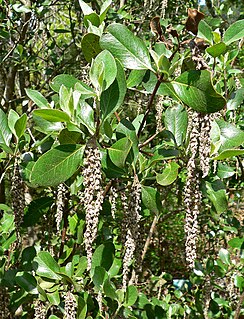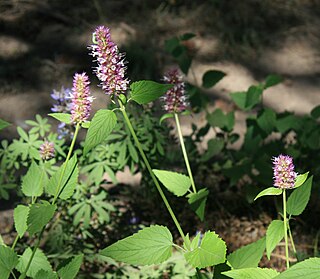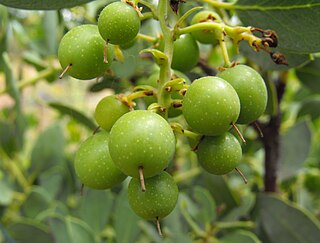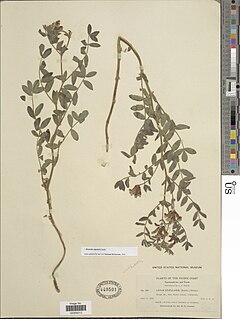
Garrya buxifolia is a species of flowering shrub, known by the common names dwarf silktassel and boxleaf silktassel, in the genus Garrya.

Blitum californicum is a species of flowering plant in the amaranth family known by the common names California goosefoot and (ambiguously) "Indian lettuce".

Agastache urticifolia is a species of flowering plant in the mint family known by the common name nettleleaf giant hyssop or horse mint.
Arctostaphylos glandulosa subsp. gabrielensis, known by the common name San Gabriel manzanita, is a subspecies of manzanita. It is endemic to one small area in the San Gabriel Mountains of Los Angeles County, California.

Arctostaphylos imbricata is a species of manzanita known by the common name San Bruno Mountain manzanita.

Arctostaphylos pajaroensis is a species of manzanita known by the common name Pajaro manzanita. It is endemic to California, where it is known mainly from Monterey County.

Astragalus gambelianus is a species of milkvetch known by the common name Gambel's dwarf milkvetch. It is native to California, with its distribution extending into Oregon to the north and Baja California to the south.

Astragalus lentiformis is a species of milkvetch known by the common name lens-pod milkvetch. It is endemic to the Sierra Nevada in eastern Plumas County, California, where it grows in chaparral scrub and coniferous forests.

Cercocarpus ledifolius var. intricatus is a variety of Cercocarpus ledifolius that is commonly known as little-leaf mountain mahogany.

Chenopodium fremontii is a species of flowering plant in the family Amaranthaceae known by the common name Frémont's goosefoot. Both the species' specific epithet, and the common name derive from the 19th century western pioneer John C. Frémont.
Chenopodium hians is a species of flowering plant in the family Amaranthaceae known by the common names hians goosefoot and gaping goosefoot. The Latin species name hians means "gaping".

Arctostaphylos rainbowensis is a species of manzanita known by the common name Rainbow manzanita. It is endemic to California, where it is known only from northern San Diego and southern Riverside Counties in the Peninsular Ranges.

Hosackia stipularis, synonym Lotus stipularis, is a species of legume endemic to California. It is known by the common name balsam bird's-foot trefoil. It is found in most of the northern and central coastal and inland mountain ranges and foothills. It can be found in many types of habitat, including forest, chaparral, and disturbed areas. This is a mostly erect perennial herb with a leafy, often hairy and glandular form. Its slender branches are lined with leaves each made of several leaflets up to 2 centimeters long. The leaves sometimes have prominent stipules. The inflorescence is a compact array of up to 9 pink flowers. Each flower is elongated, the corolla borne in a tubular calyx of sepals, and the entire unit may exceed a centimeter long. The fruit is a legume pod 2 or 3 centimeters long containing several beanlike seeds.
Minuartia californica, commonly known as California sandwort, is a species of flowering plant in the family Caryophyllaceae.

Oligomeris linifolia is a species of flowering plant in the small family Resedaceae known by the common name lineleaf whitepuff. It is native to parts of the Middle East and the Indian subcontinent, as well as southern Europe and North Africa, and the southwestern United States and northern Mexico. It grows in many types of habitat, including disturbed areas and saline soils, in deserts, plains, coastline, and other places. It is a fleshy annual plant, producing several erect, ribbed stems 35 to 45 centimeters in maximum height.

Ranunculus hebecarpus is a species of buttercup known by the common name delicate buttercup. It is native to western North America, including several of the western United States and Baja California, where it grows in grassland, woodland, and chaparral habitat. It is an annual herb producing a slender, hairy stem a few centimeters high or up to 30 centimeters tall. The hairy leaves are borne on long petioles. Their blades are deeply lobed or divided into three leaflets, often with toothed or lobed edges. Flowers have 3 to 5 tiny yellow petals just 1 or 2 millimeters long studded on the bulbous nectary; some flowers lack petals. The plant is most easily identified in its fruiting stage, when the infructescence is a spherical cluster of several tiny disc-shaped achenes with compressed, bristly sides.

Solidago multiradiata is a species of goldenrod known by the common names Rocky Mountain goldenrod, northern goldenrod, and alpine goldenrod. It is native to North America, where it can be found throughout the northern regions, including Alaska and most of Canada (all 3 territories plus all provinces except Prince Edward Island, including territory north of the Arctic Circle. Its distribution extends through the western United States as far south as Arizona, New Mexico, and California. It is known mostly from the subalpine and alpine climates of high mountain ranges. Its habitat includes tundra and mountain meadows.

Stillingia spinulosa is a species of flowering plant in the euphorb family known by the common name annual toothleaf. It is native to the Southwestern United States where it occurs in the creosote scrub of the deserts. It is an annual or perennial herb producing a clump of thick, leafy stems approaching a meter in maximum height. The alternately arranged leaves have shiny pointed oval blades 2 to 4 centimeters long and up to 1.2 centimeters wide which are lined with sharp teeth. The inflorescence is a stout spike of flowers 1 to 2 centimeters long. The plant is monoecious, and each spike has several male flowers at the tip and 1 or 2 fruit-bearing female flowers below these. Neither type of flower has petals. The ovary of the female flower develops into a three-lobed greenish capsule about half a centimeter wide. There is a tiny rough-surfaced seed in each of the three chambers of the fruit.

Tetracoccus hallii is a species of flowering shrub in the family Picrodendraceae, known by the common names Hall's shrubby-spurge and Hall's tetracoccus.

Tropidocarpum gracile is a species of flowering plant in the family Brassicaceae known by the common name dobie pod. It is native to California and Baja California, where it can be found in many types of habitat from coastal canyons to inland mountains and deserts in chaparral, scrub, woodlands, beaches, valleys, and washes. It is an annual herb producing a decumbent to erect, spreading, branching stem 10 to 50 centimeters in length. It is coated in short and long rough hairs. The basal leaves are up to 10 to 15 centimeters long and are divided into elongated lobes along the edges; leaves higher on the stem are shorter and sometimes less divided. The inflorescence is an open raceme of mustardlike flowers with four petals each about 4 millimeters long. The petals are yellow and sometimes purple-tinged. The fruit is a narrow silique several centimeters in length containing tiny brown seeds.

















